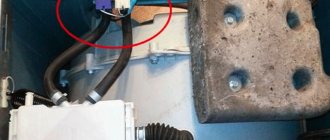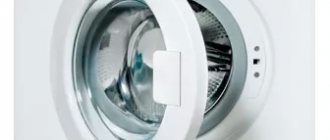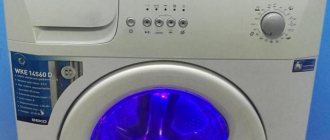Bosch washing machines are a popular product that enjoys well-deserved trust among customers. But even with very reliable equipment, malfunctions can occur and breakdowns may occur that require repair.
One such situation is very weak or absent spin. You can try to cope with the problem on your own or seek help from a washing machine repairman.
Why the Bosch washing machine does not spin clothes and what to do about it, we will tell you further.
Spin does not work - what is the reason?
Lack of spin in a Bosch washing machine does not always indicate a serious breakdown. Very often the cause of trouble is user errors.
If, after washing, the laundry removed from the drum is wet, the fault may be due to the user’s carelessness:
The spin was accidentally (or intentionally) turned off. The solution to the problem is to load the laundry again after finishing the wash and put it in spin-only processing.- Wrong choice of washing program. For example, using the mode for wool or for delicate items that do not give a strong spin.
- Overloading/underloading of the drum, as a result of which things are not wrung out well enough.
To analyze the situation, you should make sure that not a lot of things were included, and that a suitable program was set. If simple options for the cause of the spin failure are not confirmed, you need to move on to serious diagnostics and checking for technical faults.
The reasons that lead to spin problems in Bosch include:
- engine breakdown;
- wiring problems;
- clogged drain or sewer system in the apartment;
- tachometer failure;
- foreign object entering the tank;
- wear of engine brushes;
- drive belt damage;
- destruction of bearings;
- control module malfunction.
Preventive measures
Washing machines, like any household appliance, sometimes break down. But with proper care and operation, the machine will last longer than usual without malfunctions.
In order for the device to last longer, you must follow certain rules that many washing machine owners ignore:
- Before loading items into the drum of the machine, you must carefully check all pockets. If this is not done, small objects may get into the tank of the machine. This may cause blockage or malfunction.
- Do not overload the washer. However, it’s also not worth driving it idle. Load a medium amount of items into the machine drum. If you follow this rule, the drive mechanism and electric motor will last longer.
- Use your Bosch washing machine at least once a month. Leaving the equipment idle for a long time will cause its rubber bands to fail.
- Do not pour excessive amounts of washing powder into the detergent drawer. Excess powder will clog the pressure switch tube and pipes. And this will cause a malfunction.
- If possible, it is necessary to purchase a voltage stabilizer and connect the machine to the electrical network through it. This way you can protect the electronics of the washing machine from possible breakdowns.
- After each wash, you need to wipe the hatch cuff with a cloth. The same needs to be done with the powder receptacle. The hatch must be left open. The detergent drawer must be pulled out. You should also drain the remaining water to prevent it from stagnating.
Diagnostics and troubleshooting methods
Lack of spin in Bosch may indicate serious damage. To inspect the components involved in spinning, you will need to disassemble the washing machine.
To determine the cause of the problem, you need to pay attention to the “behavior” of the washing machine itself:
- is there a fault code on the display;
- does the motor start during the spin cycle?
- are there any extraneous sounds;
- whether the water left the drum after the end of the washing phase.
Engine problems
The most common problem with a Bosch washing machine motor is brush wear. This problem can arise during long-term operation and can be solved by replacing worn out consumables.
The failure manifests itself as very weak rotation of the drum during washing and spinning, uneven movements, and even a complete stop of movement. Under such circumstances, laundry cannot be well wrung.
The solution to the problem is to replace the brushes. This is a complex repair that is carried out by completely disassembling the washing machine. In case of serious engine failure (combustion), code E02 may appear on the display. If restoration is impossible, the motor is replaced.
Failure of the tachometer
The tachometer is a part of a Bosch washing machine that is responsible for controlling the number of drum revolutions. In the event of a malfunction, current information from the device is not transmitted to the control unit.
To diagnose the condition of the element, the Bosch washing machine is partially disassembled. Failure to operate the tachometer may be a consequence of a breakdown of the device itself , or be the result of a breakdown in electrical contacts.
If the sensor is broken, it is replaced with a new one. In the case where the cause of the failure is poor contact, the problem can be eliminated by replacing the wiring and tightening the fasteners. A breakdown of the tachometer is caused by the cycle starting when the drum is overloaded.
No drain
To switch to spinning, the Bosch washing machine must first drain the water. If she fails to do this, then spinning the laundry does not begin.
To check the condition of the drain system, start by cleaning the drain filter. Access to this unit is from the outside of the washing machine at the bottom. After this, you need to move on to analyzing the condition of the pump and pipe. If there is a blockage, the water will not drain from the washing machine.
It is also necessary to check the condition of the drain hose and the sewer itself . A blockage in any of the areas can result in the spin cycle not happening. The washing machine can indicate a failure by issuing code F18 (E18).
Overload, underload or imbalance of items in the drum
One of the reasons why the spin cycle may stop is that the washing machine cannot evenly distribute the laundry in the drum.
This situation can arise when wet, heavy laundry is bunched up in one lump . The inability to distribute laundry can also occur when washing only one small item, such as a T-shirt.
Another option is an imbalance when things get together, for example, when all the bed linen put in the drum ends up in the duvet cover or pillowcase when washed.
If it is impossible to distribute the laundry, the washing machine freezes and does not perform a full spin. The solution to the problem is to stop the cycle, add or subtract things, and straighten the things that are huddled together.
Foreign object in the drum
If, during washing or spinning, sounds uncharacteristic of normal operation are heard (rustling, scratching, creaking, etc.), there is a possibility that a foreign object has entered the free space between the drum and the tank .
It can not only stop rotation, but also lead to major damage - damage to the tank, burnout of the motor, etc. A foreign object will interfere with the normal rotation of the drum, which is why spinning at high speeds will not occur.
The solution to the problem is to stop the cycle. After this, you need to try to remove the object that accidentally got into the Bosch washing machine. Sometimes this can be done even without disassembling the washing machine - it is sometimes possible to remove a protruding paper clip or bra wire through the drum. But most often you will need to partially disassemble the washing machine.
Drive belt
Belt slipping at high speeds, or even falling off completely, will prevent the Bosch washing machine from spinning. If the belt breaks or falls off, the sound of a running motor will be heard , but the drum will not spin.
To resolve the problem, it is necessary to partially disassemble the Bosch washing machine in order to gain access to the unit through the removed rear wall of the case. If the belt is intact and just slipped off, it is installed in its original place.
But when this situation repeats, it is likely that the part is either installed incorrectly or requires replacement due to wear. You also need to install a new belt if it breaks. Details are in this article.
Bearing wear
A drop in spin speed, hum, noise and knocking may indicate wear of the bearing assembly .
To eliminate the defect, the Bosch washing machine will have to be completely disassembled and new bearings installed.
Replacing bearings is a complex repair that is most conveniently carried out in a workshop rather than at home.
Control module malfunction
The control unit in the Bosch washing machine coordinates the entire operation of the device. When elements and tracks burn out, various failures are possible , including lack of spinning. To carry out diagnostics, the board is dismantled.
The unit can be accessed by removing the top cover of the washing machine. In most faulty situations, the unit can be repaired. But sometimes it may need to be replaced.
Wiring irregularities
Electrical wires inside the Bosch washing machine connect the nodes and ensure the transmission of signals between sensors, working nodes and the control module. In cases of wiring problems, signals may not pass through and the smooth functioning of all groups will be disrupted. If the wiring problem concerns the components that are responsible for draining water or rotating the drum, spinning may not occur.
It is possible to determine the condition of the wiring by partially disassembling the Bosch washing machine. If breaks, loose terminals and other defects are found, repairs are carried out by a technician .
Troubleshooting
When Bosch washing equipment stops spinning clothes or does not start the spin phase at all, the first thing you need to do is unscrew and inspect the garbage filter.
If you have an automatic washing machine, this procedure must be performed. Otherwise, problems may arise related to draining dirty water, as well as starting the spin function.
Then you need to disconnect the washing equipment from the communications and take it out to a place where it can be disassembled without any problems.
Next, you need to pull out the detergent tray and place the device on the left side. To get to the pump and drain pipe, you need to remove the pan.
At the next stage, you need to unscrew the clamps, pull off the pipe and carefully inspect it. Next, the pump is dismantled. It needs to be disassembled and inspected. Particular attention should be paid to the impeller. Using a multimeter, we check the resistance of the pump.
If it is ok, you should immediately check the electric motor. After all, it’s more convenient to get to it through the bottom of the machine. We remove and check the brushes. If they are working properly, it is necessary to measure the resistance of the motor winding.
Engine problems don't happen often. The same cannot be said about brushes. If they are faulty, then we replace them with new ones.
Then you need to check the tachometer of your Bosch washing equipment. This part is located directly on the unit’s electric motor housing. You can get to the tachometer through the bottom of the machine. You need to remove it and then check the resistance with a multimeter. The faulty sensor must be replaced with a new one.
Next comes checking the pressure switch.
To do this you need:
- Unscrew the fasteners securing the top cover of the washing machine,
- Remove the top cover.
- Remove the pressure switch.
- Clean the water level sensor tube thoroughly and then blow it out. Measure the resistance. If the pressure switch is faulty, replace it with a new one.
- If the fault cannot be identified, you need to check the control module of the machine.
To diagnose and repair this part, you need to have extensive experience working with electronics. It will be extremely difficult for an ordinary user to repair the control module. In this case, it is better to seek help from a specialist.
Call the master
In cases where you cannot determine or eliminate the cause of problems with spinning on your own, you can call a specialist from a washing machine repair company. There are many such companies on the Internet.
If there is a choice, it is advisable to give preference to those who have been working in the service provision market for a long time and have many positive reviews. The cost of the work will depend on the complexity of the breakdown, and may vary significantly in different companies.
In Moscow, the average cost of Bosch repairs is:
- cleaning the drain filter – from RUB 1,300;
- replacement of the drain hose - from 1,500 rubles;
- replacement of the drain pump - from 2000 rubles;
- pipe replacement - from 1500 rubles;
- repair of the control module - about 3,000 rubles;
- removal of a foreign object – from 1500 rubles;
- finding and eliminating blockages in the drain system – from 1,400 rubles;
- motor replacement – from 2500 rubles.
After the repair is completed (at home or in the workshop), the operation of the washing machine is checked. And the master issues a guarantee. The customer pays the cost of replacement parts separately.
Simple DIY diagnostics
If you are not once, but periodically, dissatisfied with the way the machine spins things, you need to look for the cause of the malfunction. It is quite possible that the problem is trivial and easy to solve on your own. In some cases, you will need the help of a specialist.
Possible causes should be ruled out starting with the simplest ones. To begin, remove half of the items from the drum and start the spin cycle again. This is probably due to the usual overload of equipment. If the measure helped, there is no need to worry, you just need to more carefully monitor the weight of the laundry you put into the machine.
Be sure to check the parameters of the selected washing mode; perhaps spin is not provided, or its minimum speed is set.
Next, you will have to clean the elements of the drain system - the garbage filter and the drain hose. Perhaps the filter element is clogged, or a blockage has formed in the outlet “sleeve”.
If the situation does not change, check to see if there is a foreign object stuck between the tank and the drum. Usually in this case, washing is accompanied by noise that was not there before. If found, remove the item through the heating element hole.
When you wash items made from coarse fabrics and light materials at the same time in a Bosch machine, try sorting the items and spinning them separately. Sometimes this measure helps solve the problem.
If none of the above steps help, you will have to dig deeper. Perhaps the reason lies in a worn-out bearing assembly, a broken tachometer, or a “burnt out” drain pump. We need to inspect the heating element and engine. If necessary, replace the faulty part with a new one.
If you do not know how to disassemble the washing machine and have no idea about its structure, it is better to invite a specialist.










